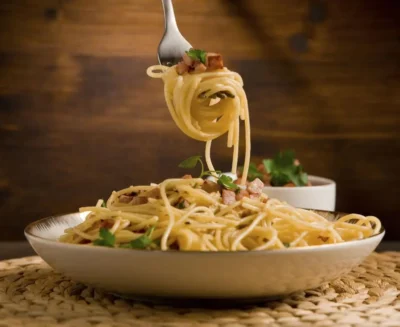
Pasta Carbonara
Pasta Carbonara is a classic Italian dish that is both simple and elegant, featuring spaghetti tossed in a creamy sauce made from eggs, cheese, pancetta, and freshly ground black pepper. This dish is the epitome of Italian comfort food, where the richness of the sauce is perfectly balanced by the salty crispiness of the pancetta and the sharpness of Pecorino Romano cheese.
Equipment
- Large pot for boiling pasta
- Large skillet or frying pan
- Mixing bowl
- Whisk
- Cheese grater
Ingredients
- 400 g about 14oz spaghetti
- 150 g about 5oz pancetta or guanciale, cubed
- 2 large eggs and 2 egg yolks
- 1 cup Pecorino Romano cheese - freshly grated
- Freshly ground black pepper - to taste
- Salt - to taste
- Fresh parsley - chopped (optional, for garnish)
Instructions
- Cook the Pasta: Bring a large pot of salted water to a boil. Add the spaghetti and cook according to package instructions until al dente. Reserve 1 cup of pasta water, then drain.
- Cook the Pancetta: While the pasta is cooking, heat a large skillet over medium heat. Add the pancetta and cook until it is crispy and golden brown, about 5-7 minutes. Remove from the heat.
- Mix the Sauce: In a mixing bowl, whisk together the eggs, egg yolks, and Pecorino Romano cheese. Season generously with freshly ground black pepper.
- Combine: Add the drained pasta to the skillet with the pancetta. Over low heat, pour the egg and cheese mixture onto the pasta, quickly tossing the pasta to coat it in the sauce. Add a little reserved pasta water if the sauce is too thick, until it reaches your desired consistency.
- Serve: Serve immediately, garnished with additional Pecorino Romano, black pepper, and optional parsley.
Notes
Pancetta vs. Guanciale: Traditional Carbonara uses guanciale, which is cured pork cheek. Pancetta, cured pork belly, is a more accessible alternative. Each brings a distinct flavor; use what’s available to you.
Cheese: Pecorino Romano is the cheese of choice for a traditional Carbonara, but Parmesan can be used for a slightly different, but equally delicious, flavor.
Sauce Consistency: The key to a creamy sauce is to work quickly and ensure that the eggs do not scramble. The residual heat from the pasta and pan cooks the eggs just enough to form a creamy sauce without overcooking them.
No Cream: Traditional Carbonara does not include cream; the creaminess of the dish comes solely from the eggs and cheese.
Timing: Pasta Carbonara is best served immediately, as the sauce can thicken upon standing and lose its silky texture.
Nutrition
Calories: 650kcal
Tried this recipe?Please consider Leaving a Review!